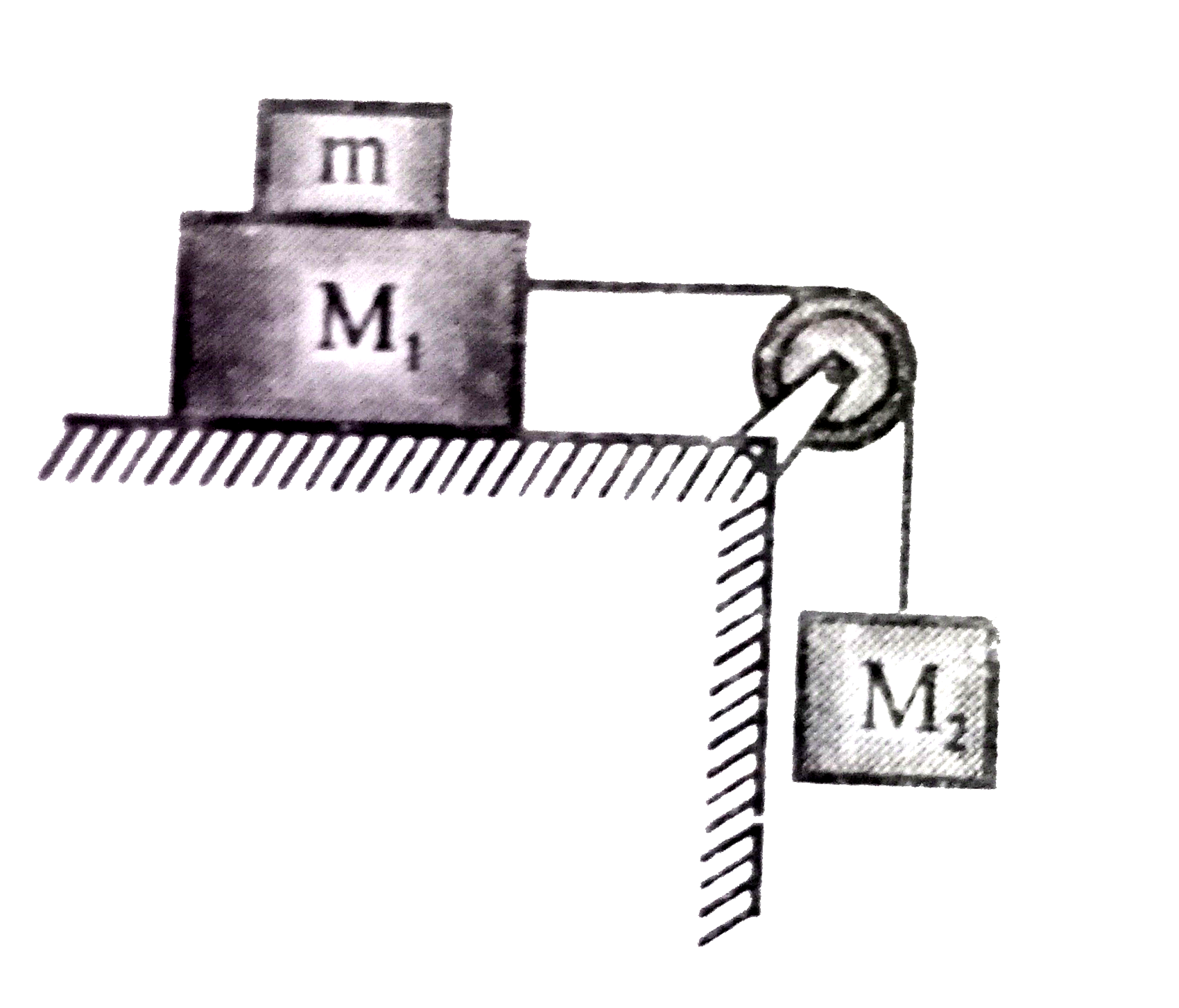Two blocks of masses 10 kg and 4 kg are connected by a spring of negligible mass and placed on a frictionless horizontal surface. An impulse gives a velocity of 14m/s to the heavier block in the direction of the lighter block. The velocity of the centre of mass is
30m/s
20m/s
10m/s
5m/s
The correct Answer is:C
To solve the problem, we need to find the velocity of the center of mass of the system consisting of two blocks of masses 10 kg and 4 kg, after an impulse is applied to the 10 kg block.
1. Identify the Masses and Initial Velocities:
- Mass of block 1 (heavier block, m1) = 10 kg
- Mass of block 2 (lighter block, m2) = 4 kg
- Initial velocity of block 1 (v1) = 14 m/s (after impulse)
- Initial velocity of block 2 (v2) = 0 m/s (at rest)
2. Calculate the Total Mass of the System:
Total mass(M)=m1+m2=10kg+4kg=14kg
3. Use the Formula for the Velocity of the Center of Mass (V_cm):
The velocity of the center of mass (V_cm) can be calculated using the formula:
Vcm=m1⋅v1+m2⋅v2M
4. Substitute the Values into the Formula:
Vcm=(10kg⋅14m/s)+(4kg⋅0m/s)14kg
Vcm=140kg m/s14kg
5. Calculate the Velocity of the Center of Mass:
Vcm=10m/s
Conclusion:
The velocity of the center of mass of the system is 10 m/s towards the direction of the 4 kg mass.
---
- Mass of block 1 (heavier block, m1) = 10 kg
- Mass of block 2 (lighter block, m2) = 4 kg
- Initial velocity of block 1 (v1) = 14 m/s (after impulse)
- Initial velocity of block 2 (v2) = 0 m/s (at rest)
Total mass(M)=m1+m2=10kg+4kg=14kg
The velocity of the center of mass (V_cm) can be calculated using the formula:
Vcm=m1⋅v1+m2⋅v2M
Vcm=(10kg⋅14m/s)+(4kg⋅0m/s)14kg
Vcm=140kg m/s14kg
Vcm=10m/s
The velocity of the center of mass of the system is 10 m/s towards the direction of the 4 kg mass.
Topper's Solved these Questions
Similar Questions
Figure shows two blocks of masses 5kg and 2kg placed on a frictionless surface and connected with a spring. An external kick gives a velocity of 14m/s to the heavier block in the direction of lighter one. Deduce (a) velocity gained by the centre of mass and (b) the separate velocities of the two blocks in the centre of mass coordinates just after the kick.
 View Solution
View SolutionTwo blocks of masses 10 kg and 20 kg are connected by a massless spring and are placed on a smooth horizontal surface. A force of 200 N is applied on 20 kg mass as shown in the diagram. At the instant, the acceleration of 10 kg mass is 12ms−2, the acceleration of 20 kg mass is:
 View Solution
View Solution
Knowledge Check
- Question 1 - Select One
Two block of masses 10 kg and 4 kg are connected by a spring of negligible mass and placed on a frictionless horizontal surface. An impluse given a velocity of 14 m/s to the heavier block in the direction of the leghter block. The velocity of centre of mass is :
A30 m/sB20 m/sC10 m/sD5 m/s - Question 2 - Select One
Two blocks of masses 5kg and 2kg are connected by a spring of negligible mass and placed on a frictionless horizontal surface. An impulse provides a velocity of 7m/s to the heavier block in the direction of the lighter block. The velocity of the centre of mass is :-
A4 m/sB5m/sC2m/sD3m/s - Question 3 - Select One
Two blocks of masses 5kg and 2kg are placed on a frictionless surface and connected by a spring. An external kick gives a velocity of 14m/s to the heavier block in the direction of lighter one. The magnitudes of velocities of two blocks in the centre of mass frame after the kick are, respectively,
A4m/s,4m/sB10m/s,4m/sC4m/s,10m/sD10m/s,10m/s
Two blocks of masses m1=1kg and m2 = 2kg are connected by a spring of spring constant k = 24 N/m and placed on a frictionless horizontal surface. The block m1 is imparted an initial velocity v0 = 12cm/s to the right. The amplitude of osciallation is
View SolutionTwo blocks of masses 10 kg and 20 kg are connected by a massless string and are placed on a smooth horizontal surface as shown in the figure. If a force F=600 N is applied to 10 kg block, then the tension in the string is
 View Solution
View SolutionTwo locks of masses 6 kg and 4 kg are placed on a frictionless surface and connected by a spring.If the heavier mass is given a velocity of 14ms−1 in th direction of lighter one,then the velocity gained by the centre of mass will be
View SolutionTwo locks of masses 6 kg and 4 kg are placed on a frictionless surface and connected by a spring.If the heavier mass is given a velocity of 14ms−1 in th direction of lighter one,then the velocity gained by the centre of mass will be
View SolutionTwo blocks of masses M1=4 kg and M2=6kg are connected by a string of negligible mass passing over a frictionless pulley as shown in the figure below. The coefficient of friction between the block M1 and the horizontal surface is 0.4. when the system is released, the masses M1 and M2 start accelrating. What additional mass m should be placed over M1 so that the masses (M1+m) slide with a uniform speed?
 View Solution
View Solution

